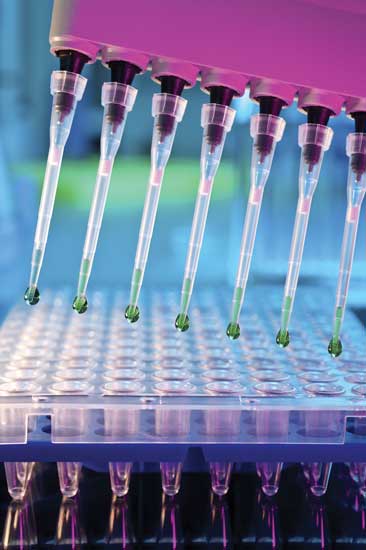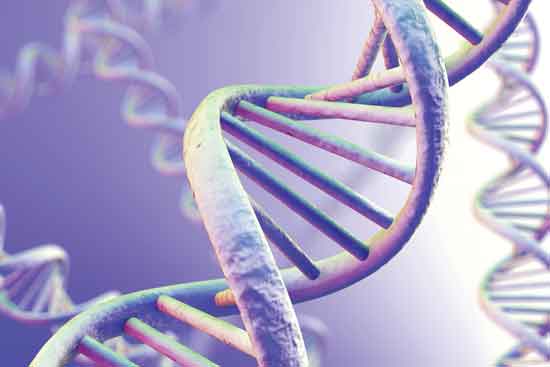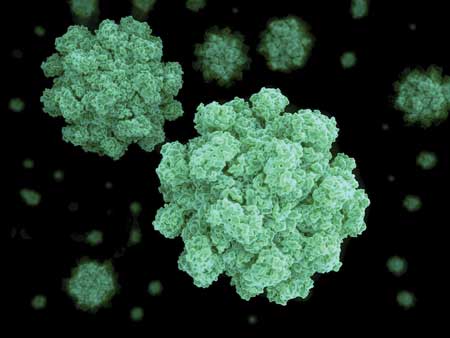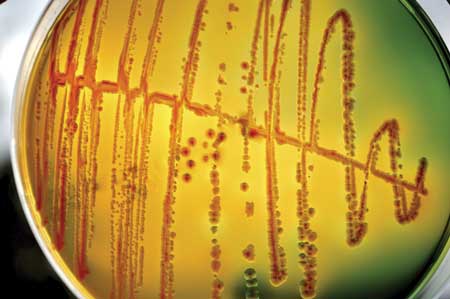Advances in Pathogen Detection
FOOD SAFETY & QUALITY
 Rapid pathogen detection methods based on advances in molecular and analytical technologies are providing better accuracy, sensitivity, reproducibility, and speed than traditional methods. To bring scientists up to date on these technologies and their potential effect on food safety and public health, the Illinois Institute of Technology’s Institute for Food Safety and Health (IFSH) and the University of Wisconsin-Madison’s Food Research Institute (FRI) held a symposium on rapid methods in food safety microbiology in September 2014. The speakers addressed four topic areas: public health applications, sampling plans and sample preparation, new technologies, and microbial ecology.
Rapid pathogen detection methods based on advances in molecular and analytical technologies are providing better accuracy, sensitivity, reproducibility, and speed than traditional methods. To bring scientists up to date on these technologies and their potential effect on food safety and public health, the Illinois Institute of Technology’s Institute for Food Safety and Health (IFSH) and the University of Wisconsin-Madison’s Food Research Institute (FRI) held a symposium on rapid methods in food safety microbiology in September 2014. The speakers addressed four topic areas: public health applications, sampling plans and sample preparation, new technologies, and microbial ecology.
Public Health Applications
Three speakers discussed how advancements in molecular microbiology, bioinformatics, and instrumentation are being implemented in public health applications.
• Eric Brown, Director, Division of Microbiology, Center for Food Safety and Applied Nutrition (CFSAN), U.S. Food and Drug Administration (FDA), said that whole genome sequencing (WGS) is rapidly transforming microbiological subtyping in the food safety laboratory. It reveals the complete DNA makeup of an organism and can differentiate organisms with greater precision than other technologies. When coupled with powerful bioinformatic pipelines, WGS can distinguish strains to the source level, including specific farms, facilities, and geographic locales, even among highly homogeneous Salmonella strains that have been difficult to differentiate by conventional typing approaches.
Brown said that early applications of WGS have shown extraordinary utility in food safety as well as the potential for complete characterization of bacterial pathogens as they emerge in the food supply. He described the FDA’s GenomeTrakr database containing the genetic makeup of thousands of foodborne disease-causing bacteria. Data from an integrated network of state and federal laboratories using WGS helps the FDA in its traceability efforts during foodborne contamination events, its regulatory casework for high-risk commodities and compliance standards, and quality assurance of food microbiological sampling programs.
• Pina M. Fratamico, Supervisory Research Microbiologist and Research Leader, Molecular Characterization of Foodborne Pathogens Research Unit, U.S. Dept. of Agriculture (USDA) described her research on testing for Shiga toxin-producing Escherichia coli (STEC), foodborne pathogens that have been associated worldwide with outbreaks and sporadic cases of gastrointestinal illness and hemolytic uremic syndrome. E. coli O157:H7 is the most commonly recognized STEC, but other E. coli serogroups known as non-O157 STEC have caused similar outbreaks and illnesses. In 2012 six serogroups responsible for the majority of cases of the non-O157 STEC illnesses were identified as adulterants in beef.
Since non-O157 STEC comprise a heterogeneous group of organisms in terms of their virulence and phenotypic characteristics, Fratamico said, the development of methods to rapidly and reliably detect and isolate them from foods has been challenging. She and her associates have optimized a method for detection of non-O157 STEC in ground beef by real-time polymerase chain reaction (PCR) targeting the eae, stx, and serogroup-specific genes with subsequent immunomagnetic separation and plating onto a selective agar, in collaboration with the USDA Food Safety and Inspection Service and industry partners. She said that challenges that still remain related to testing for non-O157 STEC include developing enrichment and isolation media suitable for all STEC, determining gene targets for screening assays to identify STEC that can cause severe disease, and accurately interpreting PCR data to identify true positive samples.
--- PAGE BREAK ---
• John Besser, Deputy Chief, Enteric Diseases Laboratory Branch, U.S. Centers for Disease Control and Prevention (CDC), said that most large outbreaks of foodborne illness in the United States are detected by the PulseNet program, a network of 87 public health and regulatory laboratories that conduct standardized molecular subtyping tests such as PFGE and MLVA on enteric disease agents. The program works by linking cases of disease that are most likely to share a common exposure, such as a food. Cases are further linked to agents discovered through food and environmental monitoring activities.
Detecting outbreaks and monitoring disease trends make it possible to detect food safety gaps that would otherwise go unrecognized and to measure the effectiveness of control efforts. Besser said that the PulseNet program has been particularly effective in this regard but the program depends on a reliable flow of bacterial isolates from clinical diagnostic and food testing laboratories. While WGS is taking subtyping to a new level, he added, it also depends on isolates for foodborne bacterial pathogens. The emergence of new syndrome-based culture-independent diagnostic tests in clinical laboratories offers many benefits to patients, doctors, and laboratories, but the tests do not result in isolates needed by PulseNet to identify outbreaks.
Similar issues are emerging in the food testing realm, Besser said. Therefore, development of new subtyping and pathogen characterization methods for public health that are culture-independent is a high priority, and a number of technologies are being considered. Metagenomics, the study of genetic material from a mixed microbial community such as the human gut, is one of the most exciting, he said, as it has the potential for operating in a culture-independent environment, consolidating diagnostic and public health workflows. It will likely change researchers’ understanding of microbial life.
Sampling Plans and Sample Preparation
Four speakers discussed isolation, concentration, and enrichment of target organisms from food and environmental samples.
• Robert L. Buchanan, Director, Center for Food Safety and Security Systems, University of Maryland, said that food microbiologists have a deep understanding of the metabolic, serologic, and genomic factors that influence the detection of microorganisms but that the principles underlying sampling protocols equally important in determining the effectiveness of microbiological testing programs are generally less understood. It is even less appreciated how these same sampling principles can play a major role in determining the effectiveness of both traditional cultural methods and rapid detection methods, particularly when the level of the target microorganism is low. He reviewed the key principles associated with the development of sampling plans, the role they play in determining the sensitivity of detection methods, and the enrichment and probabilistic barriers that have to be overcome to shorten enrichment procedures.
 • Keith A. Lampel, Supervisory Microbiologist, Division of Molecular Biology, CFSAN-FDA, said that the goal of testing foods and feed involves four essential elements: sampling, collection, preparation, and detection. The goal is to get the right answer in the shortest amount of time necessary for any matrix in question. First, sufficient sample must be collected and processed properly. One key step is that the target microorganism (e.g., pathogen) must be separated from the sample matrix, which can range from simple to complex composition. Since the number of pathogens is unknown and the amount may be low and not homogeneously distributed in the sample, an enrichment step is usually included in sample preparation protocols. Subsequent detection and isolation can be by conventional bacteriological and confirmation protocols (e.g., plating) or by rapid methods based on molecular or sero-logical science, such as PCR, biosensors, whole genome sequencing, or microarrays.
• Keith A. Lampel, Supervisory Microbiologist, Division of Molecular Biology, CFSAN-FDA, said that the goal of testing foods and feed involves four essential elements: sampling, collection, preparation, and detection. The goal is to get the right answer in the shortest amount of time necessary for any matrix in question. First, sufficient sample must be collected and processed properly. One key step is that the target microorganism (e.g., pathogen) must be separated from the sample matrix, which can range from simple to complex composition. Since the number of pathogens is unknown and the amount may be low and not homogeneously distributed in the sample, an enrichment step is usually included in sample preparation protocols. Subsequent detection and isolation can be by conventional bacteriological and confirmation protocols (e.g., plating) or by rapid methods based on molecular or sero-logical science, such as PCR, biosensors, whole genome sequencing, or microarrays.
The probability of detection is related to the amount of pathogen present, the distribution of pathogen, the number of samples taken, the amount of sample tested, and the sensitivity of the test. The probability of detection will be improved by a greater number of samples, a greater amount of sample, and a more homogeneous contamination. Things to be considered regarding sample preparation are the food matrix, the state of the pathogen (stressed or injured cells or spores), the number of cells initially present, the indigenous microbial population, the growth of pathogens versus survival, enrichment, and non-enrichment situations (e.g., viruses and parasites). At present, he said, new technologies still need to include enrichment of a culture.
Lampel added that there is a need for next-generation, high-through-put, field-deployable assays that don’t require enrichment and that can be used for non-culturable samples. The assays should also minimize target loss, maximize removal of inhibitors, combine separation and concentration steps, provide multi-analyte capabilities, improve sensitivity and specificity, and provide repeatability with robustness.
--- PAGE BREAK ---
• Katherine M.J. Swanson, President, KMJ Swanson Food Safety Inc., said that environmental testing is used to verify that the environment and process are under appropriate control from a microbiological perspective. However, environmental testing means different things to different people and one of the greatest challenges is to get establishments, regulators, researchers, and technology providers to recognize and maximize the public health benefit of using the results properly.
She said that microbial testing of food facilities can be used to verify effective control of processing and post-process contamination, identify contamination sources and sites in the processing environment, identify trends, and solve problems. Testing considerations include the target (indicator or pathogen), method (time to results, accuracy, repeatability, etc.), sample (environment, line residue, end product, location collected, and size/number of samples), frequency (daily, weekly, monthly, etc. or event-triggered), purpose (investigational, routine, regulatory, etc.), and potential action (rejection, process/practice adjustment, recall, outbreak investigation, etc.). She said that more rapid in-process tests are needed and that indicators can be more useful than specific pathogens.
 • Alvin Lee, Associate Professor and Director, Center for Processing Innovation, IFSH, said that enteric viruses, particularly human noroviruses, are the most common cause of foodborne disease, responsible for up to 50% of all outbreaks and cases per year in the United States. Unlike bacterial pathogens, for which there are widely used validated detection technologies, virus detection methods are less well-developed. The ideal detection method for noroviruses, he said, should be sensitive and specific, detect all human norovirus genotypes, provide rapid or real-time results, have a low detection limit, be easy to use and portable, require no specialized equipment, work on a variety of sample types (e.g., clinical samples, food, water) with standardized sampling protocols, and distinguish between infectious and non-infectious virus.
• Alvin Lee, Associate Professor and Director, Center for Processing Innovation, IFSH, said that enteric viruses, particularly human noroviruses, are the most common cause of foodborne disease, responsible for up to 50% of all outbreaks and cases per year in the United States. Unlike bacterial pathogens, for which there are widely used validated detection technologies, virus detection methods are less well-developed. The ideal detection method for noroviruses, he said, should be sensitive and specific, detect all human norovirus genotypes, provide rapid or real-time results, have a low detection limit, be easy to use and portable, require no specialized equipment, work on a variety of sample types (e.g., clinical samples, food, water) with standardized sampling protocols, and distinguish between infectious and non-infectious virus.
Typical methods for human norovirus detection, he said, include electron microscopy, real-time PCR, and enzyme immunoassays (EIAs). Electron microscopy requires specialized equipment and technical expertise and relatively high levels of virus but can’t distinguish between genogroups/genotypes/strains. Real-time PCR also requires specialized equipment and technical expertise, but it can detect low virus levels, provide relatively rapid results, and distinguish between genogroups. EIAs require minimal technical skill and provide rapid results, but current methods lack the sensitivity for low virus levels and are not broadly reactive. PCR techniques have improved over the past decade, but there is no standardized purification method. Lee said that the USDA National Institute of Food and Agriculture Food Virology Collaborative is working to develop methodologies.
New Technologies
Four speakers discussed new technologies for rapid detection and identification of foodborne pathogens in food and food processing environments.
• Mark Carter, owner of the consulting firm MC Squared Enterprises Inc., reviewed the market for diagnostic solutions for pathogen testing. He said that more than 25 companies provide diagnostic solutions for pathogen testing but even with the growth of the food diagnostic choices, significant public health needs are still unmet. He reviewed the newest technologies available to the food safety and quality market and technologies being developed that have the potential to significantly change food safety practices.
• Michael Koeris, founder of Sample6 Technologies, said that generating in-shift results from assay methods enables stakeholders in the food supply chain to act on data while still in control of the product or to minimize the exposure risk to the consuming public. However, he said, existing microbiological tests require 24–48 hours of enrichment after sample collection and an additional 12–24 hours in offsite shipping, followed by sample preparation, before running an assay. He described his company’s bacteriophage-based system for detecting environmental Listeria contamination in less than eight hours. Since bacteriophages only produce the reporter in living cells, automatic live/dead discrimination is an added benefit, he said.
The assay received AOAC certification after having been evaluated for Listeria species in an AOAC setting for inclusivity, exclusivity, robustness, instrument variation, and product consistency and stability, and in a method comparison study using an environmental surface. Koeris said that these data show, for the first time, that an enrichment-free assay can be run in a single shift without compromising sensitivity, specificity, and robustness.
--- PAGE BREAK ---
• Andre G. Senecal, Scientific Technical Advisor, Food Protection, DOD Combat Feeding Directorate, U.S. Army Natick Soldier Research, Development, and Engineering Center, described the development of a small handheld resistance-based biosensor for the capture and detection of pathogens in the field. The biosensor uses a non-woven nanofiber membrane disc coated with a conductive polymer and functionalized with antibodies. The functionalized electrotextile is produced by coating the non-woven membrane with either polypyrrole or poly(3,4-ethylenedioxythiophene) by either aqueous deposition or oxidative chemical vapor deposition. A copolymer containing either a carboxylic acid or a hydroxyl functional group, such as 3-thiophene acetic acid or 3-thiopheneethanol, is included with the conductive polymer and allows for covalent attachment of pathogen-specific antibodies. After exposure to a sample, the fiber disc is extracted, washed with phosphate-buffered saline, and placed between two electrodes. The fiber disc acts as an electrical conductor between the electrodes. When a current is run through the system, the presence of the captured pathogen on the fiber surface results in an increase in resistance between the two electrodes, indicating a positive result.
• Bart Weimer, Professor, Dept. of Population Health and Reproduction, University of California-Davis School of Veterinary Medicine, said that WGS is being used around the world to examine foodborne pathogen outbreaks in the food supply because of the low cost of DNA sequencing and the rapid pace of sequence production. He discussed his research group’s use of ganglioside-based pathogen capture combined with PCR for rapid serotyping of Salmonella in food. He said that adoption of next-generation sequencing by many countries is fueling the continued need to increase worldwide involvement in generating genomes from multiple isolates of the most common foodborne bacteria, and he described the 100K Pathogen Genome Sequencing Project, which is a partnership among public, private, and government agencies that is creating a reference database of 100,000 bacterial pathogens associated with food and health.
Microbial Ecology
Three speakers discussed the microbiomes of foods, food-manufacturing environments, and humans and their effects on product quality, pathogen detection, and health.
• Federico Rey, Affiliated Faculty Member, FRI, and Assistant Professor, Dept. of Bacteriology, University of Wisconsin-Madison, said that the number of microbial cells in the human body exceeds the number of human cells by about ten to one and the largest population of microbes resides in the gut. This collection of microbes and their associated genes (the gut microbiome) affects many aspects of human physiology, ranging from shaping features of the immune system to processing nutrients from the diet.
He said that gut microbial metabolism of choline, a water-soluble nutrient essential for human life, results in the production of trimethylamine (TMA), a compound that is absorbed by the host and further converted to trimethylamine N-oxide (TMAO). Studies have shown that high serum levels of TMAO exacerbate atherosclerosis in mice and are positively correlated with the severity of this disease in humans. However, the microbes that contribute to TMA production and the extent to which choline intake, age, and host genetics contribute to TMAO accumulation remain largely unknown. Rey described his group’s work on TMA-producing bacteria in the human gut and their impact on human health.
• Peter Taormina, Director of Science at John Morrell Food Group/Smithfield Foods Inc., said that the microbial ecology of raw and processed meat and poultry is diverse, complex, and dynamic and influences the detection of bacteria such as Listeria and Salmonella in processed meat and their processing environment. Meat microflora is influenced by animal husbandry practices; hygiene of the harvesting, trimming, and grinding environments; utilization of antimicrobial interventions; and storage temperatures over time. Further processing of meat by salting, curing, smoking, fermenting, cooking, final packaging, and storage temperature also alter the microbial balance, selecting for and against different microorganisms. The hygiene of personnel and the amount of product residue left in the environment also affect the microflora.
Environmental sampling and rapid detection of Listeria species is routinely used as an indicator of the potential presence of Listeria monocytogenes in meat processing environments, he said, as a means to identify high-risk areas and growth niches which are then targeted for remediation and/or intense sanitization. Accurate detection of Salmonella in certain processing environments and products is also necessary to manage and reduce risk.
 • Gregory R. Siragusa, Senior Principal Scientist for Microbiology, Antimicrobials and Antioxidants Research Team, DuPont, said that the standard plate count has been perhaps the single most utilized indicator of microbial levels and contamination of food. For more than a century, it has been varied, improved, modified, and standardized, but the information obtained has been underutilized. Microbiologists rarely actually identify the organism constituting the counted colonies, he said, for several reasons. First, perhaps a bacterial count, not identity, was the only data sought, and second, methods to identify bacteria have been cumbersome, costly, and labor- and time-intensive. However, high-throughput DNA sequencing now makes it possible to routinely and inexpensively identify and obtain population estimates of microbiomes directly from foods as well as cultures. He described the use of microbiomics—the genomic sequenced-based description of the members of microbial communities—to routinely and rapidly obtain detailed microbiomes of such foods as dairy products, packaged meats, and mixed component foods. Microbiomics, he said, reveals the uncultured and the previously unidentified cultured microbial populations in food.
• Gregory R. Siragusa, Senior Principal Scientist for Microbiology, Antimicrobials and Antioxidants Research Team, DuPont, said that the standard plate count has been perhaps the single most utilized indicator of microbial levels and contamination of food. For more than a century, it has been varied, improved, modified, and standardized, but the information obtained has been underutilized. Microbiologists rarely actually identify the organism constituting the counted colonies, he said, for several reasons. First, perhaps a bacterial count, not identity, was the only data sought, and second, methods to identify bacteria have been cumbersome, costly, and labor- and time-intensive. However, high-throughput DNA sequencing now makes it possible to routinely and inexpensively identify and obtain population estimates of microbiomes directly from foods as well as cultures. He described the use of microbiomics—the genomic sequenced-based description of the members of microbial communities—to routinely and rapidly obtain detailed microbiomes of such foods as dairy products, packaged meats, and mixed component foods. Microbiomics, he said, reveals the uncultured and the previously unidentified cultured microbial populations in food.
 Neil H. Mermelstein,
Neil H. Mermelstein,
a Fellow of IFT, is Editor Emeritus of Food Technology
[email protected]


